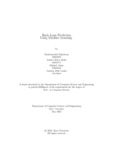| dc.contributor.advisor | Nahim, Nabuat Zaman | |
| dc.contributor.author | Mahottam, Parthosarothi | |
| dc.contributor.author | Anika, Antara Raida | |
| dc.contributor.author | Jahan, Dilshad | |
| dc.contributor.author | Lazika, Tanzina Afrin | |
| dc.date.accessioned | 2023-12-17T05:51:23Z | |
| dc.date.available | 2023-12-17T05:51:23Z | |
| dc.date.copyright | 2023 | |
| dc.date.issued | 2023-05 | |
| dc.identifier.other | ID 19101291 | |
| dc.identifier.other | ID 19101574 | |
| dc.identifier.other | ID 18101453 | |
| dc.identifier.other | ID 21141004 | |
| dc.identifier.uri | http://hdl.handle.net/10361/21984 | |
| dc.description | This thesis is submitted in partial fulfillment of the requirements for the degree of Bachelor of Science in Computer Science, 2023. | en_US |
| dc.description | Cataloged from PDF version of thesis. | |
| dc.description | Includes bibliographical references (page 33). | |
| dc.description.abstract | The Banking sector is a core foundation of the global economy as it facilitates the
financial transactions while providing fundings in various purposes. One key aspect
in the banking industry is the ability to accurately predict loan outcomes, which
requires assessing the credit worthiness of the loan applicants. Traditional methods
of loan prediction are often time consuming, it lacks transparency and interpretability
which makes it challenging for the stakeholders to understand the factors that
influence loan decisions. With the new addition of machine learning in technology
there is an opening to enhance the loan eligibility prediction models and provide
transparent insights into the decision-making process. This thesis aims to explore
the application of machine learning models and XAI methods for bank loan prediction
with a focus on improving accuracy and to get better experience on bank loan
applications for both parties. The primary objective here is to develop a robust
machine learning model that is capable of accurately predicting loan eligibility and
to leverage XAI techniques to explain the reasoning behind these predictions.The
research methodology involves a deep analysis from a dataset collected from the
internet. The dataset contains various information such as : credit history, loan
amount, self employment, earnings etc. Then initial data pre-processing techniques
which includes data cleaning or filtering, feature selection and handling values are
applied to ensure the quality and the consistency of the dataset. After that, few
machine learning models were applied such as: Decision tree, Random forest, NNC
etc to build the predictive model. These models are trained and evaluated using
appropriate performance metrics such as accuracy, F1-score and AUC(Area under
the ROC Curve) score. The goal is to identify the most effective algorithms by
comparing them between each other for loan eligibility prediction based on dataset
characteristics. Finally, to enhance the transparency and interpretability of the loan
prediction models, XAI techniques are applied.These methods facilitate the comprehension
of the factors influencing loan decisions, thereby mitigating issues of bias,
discrimination, and unfairness. Interpretability techniques, such as analysing feature
importance by employing LIME (Local Interpretable Model-agnostic Explanations),
are utilised to offer clear and comprehensible explanations for the predictions made
by the model. Furthermore, the thesis investigates the ethical implications and fairness
considerations associated with loan prediction models. The experimental results
demonstrate the efficacy of the proposed approach accurately predicting outcomes
while providing interpretable explanations for these predictions. Finally, by utilising
machine learning and XAI approaches, this thesis contributes to the subject of bank
loan prediction. It provides a complete framework for constructing loan prediction
models that are accurate, interpretable, and fair. | en_US |
| dc.description.statementofresponsibility | Parthosarothi Mahottam | |
| dc.description.statementofresponsibility | Antara Raida Anika | |
| dc.description.statementofresponsibility | Dilshad Jahan | |
| dc.description.statementofresponsibility | Tanzina Afrin Lazika | |
| dc.format.extent | 40 pages | |
| dc.language.iso | en | en_US |
| dc.publisher | Brac University | en_US |
| dc.rights | Brac University theses are protected by copyright. They may be viewed from this source for any purpose, but reproduction or distribution in any format is prohibited without written permission. | |
| dc.subject | XGBoost | en_US |
| dc.subject | Decision tree | en_US |
| dc.subject | LIME | en_US |
| dc.subject | XAI(Explainable artificial intelligence) | en_US |
| dc.subject.lcsh | Machine learning | |
| dc.subject.lcsh | Artificial intelligence | |
| dc.title | Bank loan prediction using machine learning | en_US |
| dc.type | Thesis | en_US |
| dc.contributor.department | Department of Computer Science and Engineering, Brac University | |
| dc.description.degree | B.Sc. in Computer Science and Engineering | |

